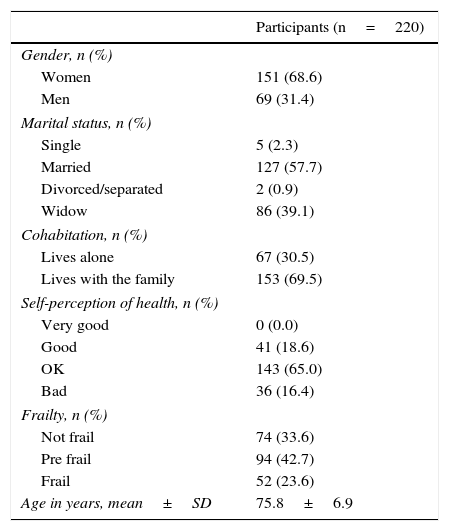Frailty is a clinical syndrome characterised, among other signs, by involuntary weight loss and decreased muscle strength. The aim of this study was to analyse associations between frailty, body composition and nutritional status in non-institutionalised elderly people in the municipality of Alfândega (Braganza-Portugal).
MethodObservational, prevalence and association study involving 220 elderly (mean 75.8±6.8 years of age; 68.8% women). Frailty was assessed according to Fried criteria, body composition by bioelectrical impedance analysis and nutritional status using the Mini Nutritional Assessment Short-Form.
ResultsThe prevalence of frailty was 23.6%. Frail participants had, on average, lower total muscle mass and lower segmental muscle mass (arms and legs) than pre-frail and non-frail (p<0.001). From the elderly at risk of malnutrition or undernourished (n=24), the majority (n=13) had frailty syndrome. It was observed that 41.2% of the elderly with low weight were frail. This syndrome prevailed only in 17.1% of the eutrophic persons, increasing again to 22.4% in the overweight group (p<0.001).
ConclusionThe phenotypic profile of frail elderly was characterised by lower muscle mass. The results of our study suggest that both underweight and overweight may be associated with frailty. There is the need to prevent and manage frailty, not only taking into account possible treatable medical causes, but also by intervening in important pillars, such as physical activity, dietary and nutritional problems.
La fragilidad es un síndrome clínico caracterizado, entre otros signos, por la pérdida involuntaria de peso y fuerza muscular disminuida. El objetivo de este estudio fue analizar asociaciones entre fragilidad, composición corporal y estado nutricional en ancianos no institucionalizados del municipio de Alfândega (Braganza-Portugal).
MétodoEstudio observacional, de prevalencia y asociación cruzada en el que participaron 220 ancianos (edad media de 75,8±6,8 años; 68,8% mujeres). La fragilidad fue evaluada según el fenotipo de Fried, la composición corporal por impedancia bioeléctrica y el estado nutricional mediante el Mini Nutritional Assessment Short-Form.
ResultadosLa prevalencia de fragilidad fue del 23,6%. Los participantes frágiles presentaban, en promedio, menor masa muscular total y menor masa muscular por segmentos (brazos y piernas) que los prefrágiles y no frágiles (p<0,001). De aquellos ancianos en riesgo de desnutrición o desnutridos (n=24), la mayoría (n=13) presentaban síndrome de fragilidad. Se observó que el 41,2% de los ancianos con bajo peso eran frágiles. Dicho síndrome prevaleció tan solo en el 17,1% de las personas eutróficas, aumentando de nuevo al 22,4% en el grupo con sobrepeso (p<0,001).
ConclusiónEl perfil fenotípico de los ancianos frágiles se caracterizó por menor masa muscular. Los resultados de nuestro estudio sugieren que tanto el bajo peso como el sobrepeso podrán conducir a situaciones de fragilidad. Es fundamental prevenir y gestionar la fragilidad, no solo teniendo en cuenta las posibles causas médicas tratables, sino también interviniendo en pilares importantes, como la actividad física y los problemas dietéticos y nutricionales.









